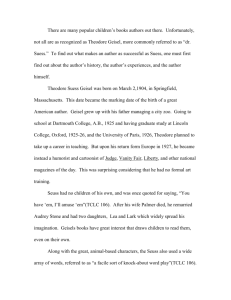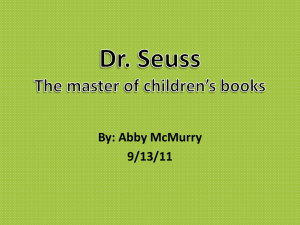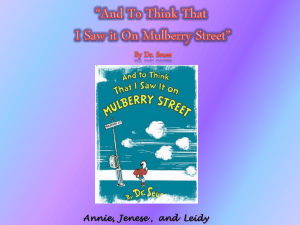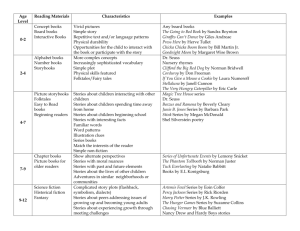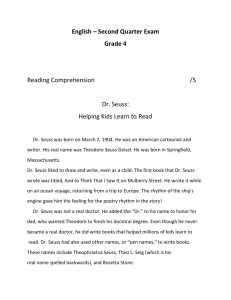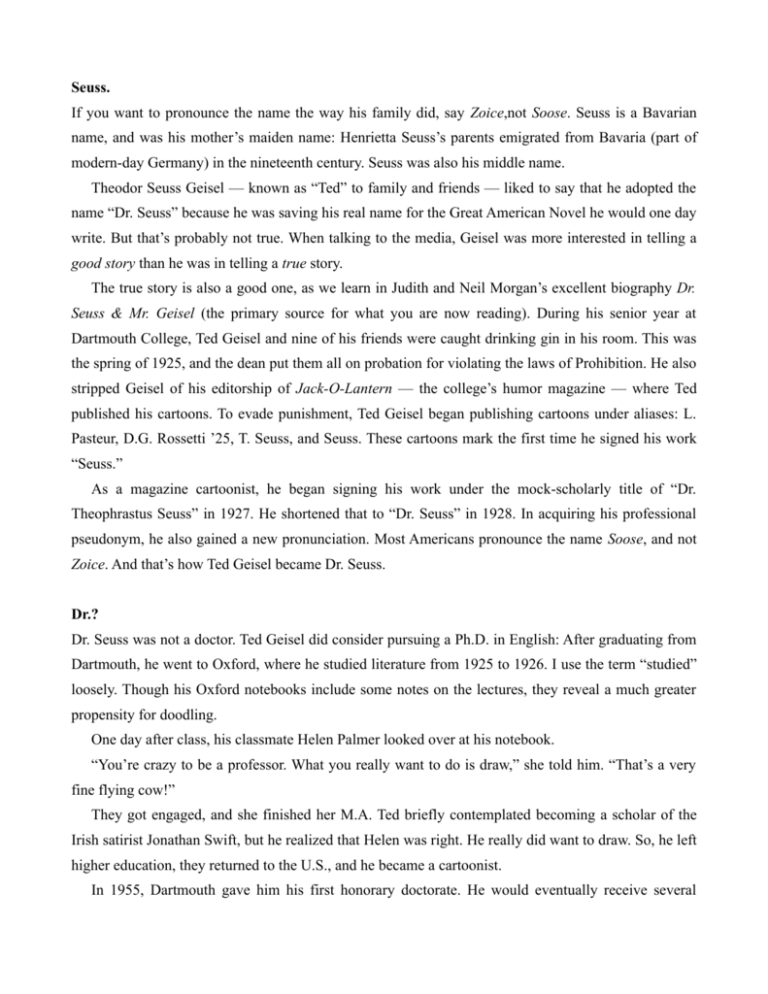
Seuss.
If you want to pronounce the name the way his family did, say Zoice,not Soose. Seuss is a Bavarian
name, and was his mother’s maiden name: Henrietta Seuss’s parents emigrated from Bavaria (part of
modern-day Germany) in the nineteenth century. Seuss was also his middle name.
Theodor Seuss Geisel — known as “Ted” to family and friends — liked to say that he adopted the
name “Dr. Seuss” because he was saving his real name for the Great American Novel he would one day
write. But that’s probably not true. When talking to the media, Geisel was more interested in telling a
good story than he was in telling a true story.
The true story is also a good one, as we learn in Judith and Neil Morgan’s excellent biography Dr.
Seuss & Mr. Geisel (the primary source for what you are now reading). During his senior year at
Dartmouth College, Ted Geisel and nine of his friends were caught drinking gin in his room. This was
the spring of 1925, and the dean put them all on probation for violating the laws of Prohibition. He also
stripped Geisel of his editorship of Jack-O-Lantern — the college’s humor magazine — where Ted
published his cartoons. To evade punishment, Ted Geisel began publishing cartoons under aliases: L.
Pasteur, D.G. Rossetti ’25, T. Seuss, and Seuss. These cartoons mark the first time he signed his work
“Seuss.”
As a magazine cartoonist, he began signing his work under the mock-scholarly title of “Dr.
Theophrastus Seuss” in 1927. He shortened that to “Dr. Seuss” in 1928. In acquiring his professional
pseudonym, he also gained a new pronunciation. Most Americans pronounce the name Soose, and not
Zoice. And that’s how Ted Geisel became Dr. Seuss.
Dr.?
Dr. Seuss was not a doctor. Ted Geisel did consider pursuing a Ph.D. in English: After graduating from
Dartmouth, he went to Oxford, where he studied literature from 1925 to 1926. I use the term “studied”
loosely. Though his Oxford notebooks include some notes on the lectures, they reveal a much greater
propensity for doodling.
One day after class, his classmate Helen Palmer looked over at his notebook.
“You’re crazy to be a professor. What you really want to do is draw,” she told him. “That’s a very
fine flying cow!”
They got engaged, and she finished her M.A. Ted briefly contemplated becoming a scholar of the
Irish satirist Jonathan Swift, but he realized that Helen was right. He really did want to draw. So, he left
higher education, they returned to the U.S., and he became a cartoonist.
In 1955, Dartmouth gave him his first honorary doctorate. He would eventually receive several
more honorary degrees, including one from Princeton. By pursuing his love of drawing, Ted Geisel
became one of the few people to earn a Ph.D. by dropping out of graduate school.
Quick, Henry, the Flit!
Success was not immediate. Ted married Helen in 1927, and they moved into a walk-up apartment on
New York’s Lower West Side while he tried to establish himself as a cartoonist. After a year of scraping
by, Ted chanced upon the career that would make him famous: advertising. It all began when he
happened to use a popular insecticide for a punchline. For a 1928 issue of Judge magazine, Seuss drew
a cartoon in which a knight remarks, “Darn it all, another dragon. And just after I’d sprayed the whole
castle with Flit!” The wife of an advertising executive saw the cartoon and asked her husband to hire
Seuss to write ads for Flit.
In a typical Flit cartoon, large mosquitoes converge on a child at a picnic. His mother cries, “Quick,
Henry, the Flit!” Father (Henry) looks for the Flit to save the day. In another, a ventriloquist’s dummy
sees a giant insect heading for him. To the astonishment of the ventriloquist, the dummy shouts,
“Quick, Henry, the Flit!”
Dr. Seuss’s ad campaign was a hit. “Quick, Henry, the Flit!” was the “Got Milk?” or the “Where’s
the Beef?” of its day — a catchphrase that everyone knew. As Robert Cahn wrote in his 1957 profile of
Seuss, “‘Quick Henry, the Flit’ became a standard line of repartee in radio jokes. A song was based on
it. The phrase became a part of the American vernacular for use in emergencies. It was the first major
advertising campaign to be based on humorous cartoons.”
Seuss went on to create ads for Holly Sugar, NBC, Ford, General Electric, and many others. For the
next thirty years, advertising would remain Ted Geisel’s main source of income. The Cat in the Hat
would change all that.
“You make ’em. I’ll amuse ’em”
The Cat in the Hat (1957) was Seuss’s thirteenth children’s book. And to Think That I Saw It on
Mulberry Street (1937) was his first. He wrote an even earlier, unpublished children’s book in 1931.
Why did he decide to write for children? Geisel often said that a clause in his contract with Standard
Oil (makers of Flit) prohibited him from undertaking many other types of writing, but not from writing
children’s books. As he told scholar and Dartmouth librarian Edward Connery Lathem in 1975, “I
would like to say I went into children’s book writing because of my great understanding of children. I
went in because it wasn’t excluded by my Standard Oil contract.”
This might be true. However, given his tendency to embellish, there may be other truths he’s
avoiding. Geisel wrote his first children’s book in the same year that Helen learned she could not have
children.
To silence friends who bragged about their own children, Ted liked to boast of the achievements of
their imaginary daughter, Chrysanthemum-Pearl. He even dedicated The 500 Hats of Bartholomew
Cubbins (1938) — his second children’s book — to “Chrysanthemum-Pearl (aged 89 months, going on
90).” He included her on Christmas cards, along with Norval, Wally, Wickersham, Miggles, Boo-Boo,
Thnud, and other purely fictional children. For a photograph used on one year’s Christmas card, Geisel
even invited in half a dozen neighborhood kids to pose as his and Helen’s children. The card reads, “All
of us over at Our House / Wish all of you over at / Your House / A very Merry Christmas,” and is
signed “Helen and Ted Geisel and the kiddies.”
Perhaps curious to know what his own kiddies might have been like, in 1939 he and business
partner Ralph Warren tried to invent an Infantograph, which promised to show how a couple’s children
would look. Although they never quite got it to work, Geisel did write advertising copy for the
camera’s expected debut at the World’s Fair: “IF YOU MARRIED THAT GAL YOU’RE WALKING
WITH, WHAT WOULD YOUR CHILDREN LOOK LIKE? COME IN AND HAVE YOUR
INFANTOGRAPH TAKEN!”
His fourth children’s book, Horton Hatches the Egg (1940), is about an adoptive father. Horton
looks after Mayzie’s egg and, when it hatches, becomes the newborn elephant-bird’s parent.
People often asked Dr. Seuss how he, a childless person, could write so well for children. His
standard response: “You make ’em. I’ll amuse ’em.” The question ignores the fact that many great
children’s writers had no children of their own: Lewis Carroll, Edward Lear, Beatrix Potter, Margaret
Wise Brown, Crockett Johnson, and Maurice Sendak, to name a few. That said, Seuss’s funny answer
may conceal a private sadness. As he told his niece Peggy, “it was not that we didn’t want to have
children. That wasn’t it.”
Or he may be telling the truth about the Standard Oil contract. Or both may be true.
When he married the former Audrey Stone, who in 1968 would become his second wife, Ted Geisel
acquired two stepdaughters: fifteen-year-old Lark and eleven-year-old Lea. However, for over half of
his career as a children’s author, Dr. Seuss had no children.
And to Think That I Saw It on Mulberry Street
No one wanted to publish his first children’s book — an ABC of fanciful creatures, including the longnecked whizzleworp and the green-striped cholmondelet. Several years later, he tried once more with a
new book. Again, publisher after publisher turned it down.
The new book had seemed like a good idea. Aboard a ship, crossing the Atlantic in 1936, Geisel
kept himself entertained by putting words to the rhythms of the ship’s engines: “And to think that I saw
it on Mulberry Street.” This phrase grew into a story of a young boy named Marco imagining an
increasingly fantastic parade. When Geisel arrived back home, he revised the text, added illustrations,
and created a picture book.
Depending on the version of the story he tells, either 20, 26, 27, 28, or 29 publishers rejected the
book. Geisel was walking down Madison Avenue, about to throw the book away, when he ran into
former classmate Mike McClintock, who had just been appointed juvenile editor of Vanguard Press.
McClintock promptly took him up to his office (Vanguard’s offices were on Madison), where they
signed a contract for Mulberry Street. As Geisel puts it, “That’s one of the reasons I believe in luck. If
I’d been going down the other side of Madison Avenue, I would be in the dry cleaning business today!”
Would Seuss really have gone into the dry cleaning business? That’s unlikely. But the “dry cleaning”
line makes for a better story.
The Political Seuss - HORTON HEARS A WHO.
Dr. Seuss published his fourth children’s book in 1940, and started on his fifth, McElligot’s Pool, in
early 1941. But that book would not appear for another six years.
He was worried about the expanding world war. As he put it, “While Paris was being occupied by
the klanking tanks of the Nazis and I was listening on my radio, I found I could no longer keep my
mind on drawing pictures of Horton the Elephant. I found myself drawing pictures of Lindbergh the
Ostrich.” Seuss is referring to Charles Lindbergh, the world-renowned American pilot and prominent
isolationist. Lindbergh and other members of the America First Committee thought that the U.S. should
stay out of the wars in Europe and the Pacific.
Seuss disagreed. As he later wrote, “We were going to have no choice in the matter.” If war with the
Axis powers (Germany, Italy, Japan) was inevitable, then, Seuss thought, the U.S. had better get
prepared. Deciding to convince his fellow citizens that they needed to prepare for war, Seuss set aside
McElligot’s Pool and began his twenty-one-month career as a political cartoonist, publishing over 400
cartoons for the liberal New York newspaper PM between April 1941 and January 1943.
His cartoons make fun of isolationists. They mock the leaders of the Axis powers — Adolf Hitler,
Benito Mussolini, and Hideki Tojo. They oppose fascism. They criticize discrimination against Jews
and against African Americans, at a time when such discrimination was both legal and common.
Seuss’s sensitivity to social injustice stems from his adolescence, the period of his life that he
considered the source of his creativity. (Asked how much his childhood influenced his work, Seuss
replied, “I think I skipped my childhood,” but “I used my adolescence.”) His grandfather had emigrated
from Germany in the nineteenth century and, during the First World War, young Ted Geisel was teased
for being a German American. Classmates carrying brickbats chased him as they shouted, “Kill the
Kaiser!” Fearing persecution, the Geisels’ Lutheran church stopped holding services in German and
began holding services in English.
In 1921, his freshman year at Dartmouth College, no fraternities invited him to pledge. As he told
his biographers, “With my black hair and long nose, I was supposed to be Jewish. It took a year and a
half before word got around that I wasn’t. I think my interest in editing the Dartmouth humor magazine
[Jack-O-Lantern] began … that Pledge Week.”
It’s no coincidence that the boy picked on for his ethnicity and his (presumed) religion would grow
up to create cartoons that attack prejudice. After the war, he brought his political message to his
children’s books. A tale of a tyrannical turtle who builds his empire on the backs of his suffering
citizens, Yertle the Turtle (1958) took its inspiration from the rise of Hitler. At the book’s conclusion,
Mack — spokesturtle for his oppressed countrymen — burps, toppling the dictator Yertle. And the
“turtles, of course … all the turtles are free / As turtles and, maybe, all creatures should be.” Seuss’s
opposition to anti-Semitism inspired The Sneetches (1961), a story in which star-bellied Sneetches
discriminate against star-less Sneetches. At story’s end, they learn that “Sneetches are Sneetches / And
no kind of Sneetch is the best on the beaches.”
A 1953 visit to Japan served as part of the inspiration of one of his most powerful anti-prejudice
books: Horton Hears a Who! (1954). Dedicated to a Kyoto University professor he met on his trip, the
book dramatizes the plight of the Whos, inhabitants of a planet threatened with destruction unless
others (such as Horton) stand up for them. Who-ville facing annihilation suggests a parallel with two
Japanese cities facing atomic bombs (dropped by the U.S. in 1945, ending the Second World War).
But the Whos could stand for any group of people threatened by a more powerful group. In the
book’s memorable refrain, “A person’s a person, no matter how small,” the Whos’ small size is an
arbitrary mark of difference — such as race, creed, sex, or nationality. As the Des Moines Register said
in its review, the book offers “a rhymed lesson in protection of minorities and their rights.”
Seuss’s activist children’s books tell readers that even the smallest, apparently insignificant person
has an important role to play. In Yertle the Turtle,
That plain little turtle below in the stack,
That plain little turtle whose name was just Mack
Decided he’d taken enough. And he had.
And that plain little lad got a little bit mad
And that plain little Mack did a plain little thing.
He burped!
And his burp shook the throne of the king!
“Plain little” Mack burps, toppling the king. In Horton Hears a Who!, Who citizens take to the
streets to protest, but not until even the tiniest Who speaks up do they finally make themselves heard.
When the mayor tells him, “open your mouth, lad! For every voice counts!,” little Jo-Jo shouts
“YOPP!” and, finally, the Whos are heard, and those who were indifferent decide to protect them. As
Horton says, “They’ve proved they ARE persons, no matter how small. / And their whole world was
saved by the Smallest of All!” Reading books like these, children may get the message that even
smallish Whos and little turtles can speak out and make a difference. This is a powerful lesson for
young people to learn.
American Poet Laureate of Nonsense
No matter what readers learn from Seuss’s books, they will most likely learn it in rhyme. Of the fortyfour books written and illustrated by Dr. Seuss, only four are in prose. If we add books illustrated by
others, or written under another name, or co-authored, or published posthumously, then the total
number of books is sixty-six, with only five in prose.
Why did Seuss prefer poetry? Grandpa Seuss was a baker, and Ted’s mother, Henrietta Seuss,
worked in her father’s bakery before becoming Mrs. Geisel in 1901. As the Morgans note, Ted and his
older sister, Marnie, often went to sleep to the sound of their mother chanting to them “softly, in the
way she had learned as she sold pies, ‘Apple, mince, lemon … peach, apricot, pineapple … blueberry,
coconut, custard, and SQUASH!’” He later said that his mother was most responsible “for the rhythms
in which I write and the urgency with which I do it.”
Along with Robert Frost and Billy Collins, Dr. Seuss is one of America’s most popular poets. One
reason that he rarely receives the respect that they do is that Seuss writes for children. Some critics look
down their noses at “kiddie lit,” refusing to understand that, though written for people with less height
or less vocabulary, children’s literature is not a lesser genre. It is literature, and good children’s
literature is as worthy of praise as good literature for grown-ups.
The other reason Seuss’s poetic talents receive less notice is that he usually writes in the meter of
the limerick, a form that gets little respect. Horton’s “I meant what I said and I said what I meant” has
but one anapest more than “There was an Old Man with a beard.” An anapest is two unstressed
syllables followed by a stressed syllable — da-da-duh. Seuss sometimes introduces an initial anapest
with an iamb, which is one unstressed syllable followed by a stressed syllable — da-duh. See, for
example, “A person’s a person, no matter how small” or “I’m Yertle the Turtle! Oh, marvelous me! /
For I am the ruler of all that I see!”
Seuss, however, is a powerful poet. He’s one of the few to change the language. Edward Lear’s
“The Owl and the Pussycat” introduced runcible spoon. Lewis Carroll’s “Jabberwocky” coined both
galumphing (a combination of galloping and triumphant) and chortle (chuckle plus snort). The word
nerd first appears in Seuss’s If I Ran the Zoo
As his nonsense-poet predecessors did, Seuss invented a variety of animals and plants. Carroll gave
us the Jabberwock, and Shel Silverstein, the Flying Festoon. Lear created the Jumblies, the Quangle
Wangle, the Dong with a luminous Nose, and a wide range of fantastical flora. Seuss’s prodigious
imagination created more, I think, than even Lear’s. In Scrambled Eggs Super! (1953) alone, Peter T.
Hooper meets the Ruffle-Necked Sala-ma-goox, the Tizzle-Topped Grouse, the Shade-Roosting Quail,
the Lass-a-lack, the Spritz, the Flannel-Wing Jay, the Twiddler Owl, the Kweet, the Stroodel, the
Kwigger, the Long-Legger Kwong, the Grice, the Pelf, the Single-File Zummzian Zuks, the Mt.
Strookoo Cuckoo, the three-eyelashed Tizzy, the Grickily Gractus, the Ziff, the Zuff, the MothWatching Sneth, the Dawf, the Bombastic Aghast, the Mop-Noodled Finch, the Beagle-Beaked-BaldHeaded-Grinch (apparently unrelated to the Christmas-stealing Grinch), Wogs (“the world’s sweetest
frogs”), the Ham-ikka-Schnim-ikka-Schnam-ikka Schnopp, and a Jill-ikka-Jast. And that’s only one of
Seuss’s bestiary books. He wrote nine more, each of which includes between a dozen to several dozen
imaginary animals.
Oh, the Thinks He Could Think!
People often asked Dr. Seuss where he got his ideas. Since Seuss wasn’t sure himself, he tended to
invent answers. As he told one such questioner:
This is the most asked question of any successful author. Most authors will not disclose their source
for fear that other, less successful authors will chisel in on their territory. However, I am willing to take
that chance. I get all my ideas in Switzerland, near the Forka Pass. There is a little town called Gletch,
and two thousand feet up above Gletch there is a smaller hamlet called Uber Gletch. I go there on the
fourth of August every summer to get my cuckoo clock repaired. While the cuckoo is in the hospital, I
wander around and talk to the people in the streets. They are very strange people, and I get my ideas
from them.
Though many of his inspirations were mysteries to him, Seuss based two of his most famous
characters on himself: the Grinch and the Cat in the Hat. In December 1957, just after How the Grinch
Stole Christmas! appeared, Seuss explained the origins of the story to Redbook magazine:
I was brushing my teeth on the morning of the 26th of last December when I noted a very Grinchish
countenance in the mirror. It was Seuss! Something had gone wrong with Christmas, I realized, or more
likely with me. So I wrote the story about my sour friend, the Grinch, to see if I could rediscover
something about Christmas that obviously I’d lost.
To accompany the article, he has drawn a self-portrait of Geisel looking into his bathroom mirror
and the Grinch looking back. Seuss told many variations on this story, but he always mentions his
identification with the Grinch, once describing him as a “nasty anti-Christmas character that was really
myself.”
Although his license plate read “GRINCH,” Seuss also identified with the Cat in the Hat. A selfportrait of himself as the Cat accompanied a profile in the Saturday Evening Post of July 6, 1957. As
his editor Michael Frith once remarked, “The Cat in the Hat and Ted Geisel were inseparable and the
same. I think there’s no question about it. This is someone who delighted in the chaos of life, who
delighted in the seeming insanity of the world around him.” But the Cat in the Hat is more than just
Geisel’s alter ego.
The Cat in the Hat
Seuss wrote The Cat in the Hat because he was worried that children were not learning to read. Rudolf
Flesch’s Why Johnny Can’t Read — and what you can do about it (1955), and John Hersey’s “Why Do
Students Bog Down on the First R?” (Life, 1954) both said that boring primers like Dick and Jane were
a major cause of children failing to read. Hersey even suggested that Seuss write a better primer.
William Spaulding, whom Seuss had worked with during the Second World War and who was then the
director of Houghton Mifflin’s education division, challenged him to “Write me a story that firstgraders can’t put down!” He asked that Seuss limit the book’s vocabulary to no more than 225 different
words, choosing those words from a list of 348. (For those of you who like to know these things, The
Cat in the Hat has 236 different words. I counted them.)
Accustomed to using any words he liked or even making up words, Seuss nearly gave up when he
faced that word list. His favorite story is that frustration with the list inspired the book. As he put it, “I
read the list three times and almost went out of my head. I said, I’ll read it once more and if I can find
two words that rhyme, that’ll be the title of my book… . I found ‘cat’ and ‘hat’ and I said, The title will
be The Cat in the Hat.”
That story is probably not true. Images came to him easier than words did. In the very first
interviews he gave after the book’s publication, he says that an image of the Cat inspired the book. He
had halfway finished a story about a King Cat and a Queen Cat before he “realized the word ‘queen’
was not on the list,” Frustrated and ready to quit, he then saw his sketch of “a raffish cat wearing a
battered stovepipe hat.” He “checked his list — both ‘hat’ and ‘cat’ were on it.” So, The Cat in the Hat
became the book’s title.
The Cat himself has many literary ancestors, from Charles Perrault’s Puss in Boots to George
Herriman’s Krazy Kat, but one of the more interesting influences is a real person. Seuss told the
Morgans that he got the idea for the Cat while riding with William Spaulding in Houghton Mifflin’s
elevator. The elevator operator, Annie Williams, wore white gloves and had a sly smile — two of the
Cat’s most recognizable features.
Wherever the Cat came from, the book was an immediate hit. Published in March of 1957, The Cat
in the Hat sold nearly a million copies by the end of 1960. The book’s runaway success inspired Seuss,
his wife Helen, and Phyllis Cerf to found Beginner Books, a division of Random House that would
publish books designed to help children learn to read. In the fall of 1958, The Cat in the Hat Comes
Back and four other titles launched the Beginner Books series, which would soon include P. D.
Eastman’s Go, Dog. Go! (1961), Stan and Jan Berenstain’s The Big Honey Hunt (the first Berenstain
Bears book, 1962), and Seuss’s own Green Eggs and Ham (1960).
When publisher Bennett Cerf bet him that he could not make a book using fifty or fewer different
words, Seuss wrote Green Eggs and Ham. The book is his best-selling title. The Cat in the Hat is in
second place, followed by two more Beginner Books: One fish two fish red fish blue fish (1960) and
Hop on Pop (1963). With the exception of Oh, the Places You’ll Go! (1990), seven of the top eight
best-selling Seuss titles of all time are Beginner Books. Dr. Seuss did not start writing children’s books
with the goal of helping children learn how to read, but he became America’s best-known reading
teacher.
The Lorax and The Butter Battle Book
But Seuss did not just want to teach children how to read. He also hoped to teach them how to think. As
he wrote in an essay published in 1960, “children’s reading and children’s thinking are the rock-bottom
base upon which this country will rise. Or not rise. In these days of tension and confusion, writers are
beginning to realize that books for children have a greater potential for good or evil than any other form
of literature on earth.” He sought to nurture that potential for good in his post-war message books —
Horton Hears a Who!, Yertle the Turtle, The Sneetches, The Lorax, and The Butter Battle Book.
The latter two are Seuss at his most blunt. Anger at careless treatment of the environment inspired
The Lorax (1971). However, in trying to write an ecological fable for children, Seuss found he was
only writing “propaganda with a plot.” Though his political books have morals, Seuss disliked books
that preach at their readers. His draft of The Lorax was too preachy. He was stuck.
Thinking that a trip might get him un-stuck, Audrey (his second wife) suggested that they go to
Africa. In Kenya, sitting at his hotel swimming pool, Seuss saw “workmen cutting down trees” and
thought, “They can’t cut down my Dr. Seuss trees!” He named these trees “Truffula Trees,” and
invented the Lorax, a small, whiskery character who “speaks for the trees” because “the trees have no
voices.” Seuss then saw, in the distance, a herd of elephants ambling over the top of a hill. As he later
remembered, seeing those elephants “broke my logjam.” He wrote a full draft of the book on a laundry
list — the only paper he had handy. After he returned to La Jolla, he revised and illustrated the book,
using his remembered image of the trees for his Truffula Trees. As the Morgans note, at Audrey’s
suggestion, Seuss shifted his color palette away “from his usual primary colors to mauve, plum, purple
and sage-green.” The contrast between these bright colors depicting unspoiled nature and the grays,
browns, and dark blues of the polluted landscape deftly highlights the need to take care of the
environment. As a tribute to Audrey’s influence on the book, Dr. Seuss dedicated The Lorax to her and
her two daughters, Lark and Lea.
The title character quickly became an icon of environmental conservation. In the book, the Once-ler
(a repentant ex-industrialist) tells how he and his Thneed company polluted the environment,
destroying the Truffula Trees, driving away the Lorax and the animals. Concluding by telling readers
how they might make things right again, The Lorax advises, “Plant a new Truffula. Treat it with care. /
Give it clean water. And feed it fresh air. / Grow a forest. Protect it from axes that hack. / Then the
Lorax / and all of his friends / may come back.” Appropriately, when Keep America Beautiful gave Dr.
Seuss an award in November 1971, the anti-litter organization predicted that The Lorax would
“undoubtedly charm many children — and adults as well — into becoming pollution fighters.”
As confirmation of the book’s power, the Lorax is a fictional character with real enemies. Parents in
logging communities have tried to get the book removed from school libraries and reading lists. The
National Oak Flooring Manufacturers Association has published its own pro-logging rebuttal, Truax.
Seuss’s The Lorax has even made the American Library Association’s annual list of challenged and
banned books.
Responding to criticism of his book, Seuss said, “The Lorax doesn’t say lumbering is immoral. I
live in a house made of wood and write books printed on paper. It’s a book about going easy on what
we’ve got. It’s anti-pollution and anti-greed.”
A little over a decade later, Seuss was concerned about President Ronald Reagan’s escalation of the
nuclear arms race. So he wrote The Butter Battle Book - and as he had done with The Lorax, Seuss
dedicated the book to Audrey. The tale ends with a Yook and a Zook standing on the wall that divides
their countries, each poised to drop a Seussian nuclear bomb on the other side. The Yook’s grandson
asks, “Who’s going to drop it? / Will you … ? Or will he … ?” The reply: “‘Be patient,’ said Grandpa.
‘We’ll see. / We will see …’” With that, The Butter Battle Book ends, leaving the reader to reckon with
the problem posed.
Although some people thought this conclusion was a little too much for children, young readers
themselves wrote their own endings and sent them to Seuss. As he told USA Today at the time, “most
kids are saying ‘Why don’t we sit down and talk it over?’ That seems to be the average answer.” He
trusted children’s intelligence.
Indeed, treating children with respect was key to Seuss’s philosophy of writing for them. As he said,
“I don’t write for children. I write for people.” Or, as he once told an interviewer, “I think I can
communicate with kids because I don’t try to communicate with kids. Ninety percent of the children’s
books patronize the child and say there’s a difference between you and me, so you listen to this story. I,
for some reason or another, don’t do that. I treat the child as an equal.”
Seuss’s Legacy
In 1991, a few weeks before his death, Judith and Neil Morgan asked him if there were anything he
might have left unsaid. Seuss replied, “Any message or slogan? Whenever things go a bit sour in a job
I’m doing, I always tell myself, ‘You can do better than this.’ The best slogan I can think of to leave
with the kids of the U.S.A. would be ‘We can … and we’ve got to … do better than this.’”
Seuss wrote books that make people think and imagine. In On Beyond Zebra!, he invented an
entirely new alphabet because, as the book’s narrator explains, “In the places I go there are things that I
see / That I never could spell if I stopped with the Z. / I’m telling you this ’cause you’re one of my
friends. / My alphabet starts where your alphabet ends.” In inviting readers to create a new alphabet,
Seuss suggests that the imagination can lead to discoveries that are literally beyond words. So, to
conclude with some verse from Seuss’s Oh, the Thinks You Can Think!: “Think left and think right /
and think low and think high / Oh, the THINKS you can think up if only you try!”
As a testament to Seuss’s importance as both thinker and writer, he joins Hans Christian Andersen,
Astrid Lindgren, and Mark Twain as one of the very few writers for children to have his own public
statue. At the Dr. Seuss National Memorial Sculpture Garden in his hometown of Springfield,
Massachusetts, a bronze Ted Geisel sits in a chair next to the Cat in the Hat. Nearby are some of the
other creatures of his imagination — the Lorax, the Grinch and his dog Max, Yertle the Turtle, Horton
the Elephant, and Thidwick the Big-Hearted Moose. Lark Grey Dimond-Cates, the sculptor and
Geisel’s stepdaughter, said of the sculpture garden she designed, “I want people to leave taking Dr.
Seuss’s work a little more seriously… . I think a lot of people take Dr. Seuss’s work lightly — it’s fluff,
it’s cute. If you sit down and read his books carefully, they have so much more to them.”
At the sculpture garden’s dedication in May 2002, Audrey paused by her late husband’s likeness,
looked in his eyes, and, holding back tears, clasped his bronze hand in hers. Lark asked her mother
softly, “Is it right, Mom?” Audrey replied, “It’s Ted. It’s hard to put into words. It’s an open-ended
closure.” Mrs. Geisel may have lacked words at that time, but she has worked to extend Seuss’s moral
and artistic influence through the Dr. Seuss Foundation, which provides primary support for over one
hundred medical, cultural, and socially active institutions. As curator of the Seuss legacy, she reminds
us that — in the words of the Lorax — “UNLESS someone like you / cares a whole awful lot, / nothing
is going to get better. / It’s not.” Through the art and poetry of his books, Seuss encourages us to think
creatively, participate in society, and do what we can to make it better. As Seuss writes in his final
book, Oh, the Places You’ll Go! (1990), “You have brains in your head. / You have feet in your shoes. /
You can steer yourself / any direction you choose”:
So … be your name Buxbaum or Bixby or Bray
or Mordecai Ali Van Allen O’Shea,
you’re off to Great Places!
Today is your day!
Your mountain is waiting.
So … get on your way!
–Philip Nel
Bibliography Associated Press. “Let’s introduce a garden for Seuss.” Kansas City Star, 1 June 2002: A2. Reports the
conversation between Audrey and Lark included in the final paragraph.
Cahn, Robert. “The Wonderful World of Dr. Seuss.” Saturday Evening Post, 6 July 1957: 17–19, 42, 46. Ted Geisel
speaks of his inability to draw, writing The Cat in the Hat and Mulberry Street, meeting Helen, Flit, morals, “obsolete
children”; Helen Geisel talks about her husband’s animals and his dislike of public speaking; both discuss the Whos.
Cohen, Charles D. The Seuss, the Whole Seuss, and Nothing but the Seuss. New York: Random House, 2004. Subtitled
“A Visual Biography,” this gathers a delightful array of images from the many facets of Seuss’s career: film, advertising,
cartoons, and children’s books.
Lathem, Edward Connery. “Words and Pictures Married: The Beginnings of Dr. Seuss.” Dartmouth Alumni Magazine,
Apr. 1976: 16–21.
Minear, Richard H. Dr. Seuss Goes to War: The World War II Editorial Cartoons of Theodor Seuss Geisel. Introduction
by Art Spiegelman. New York: New Press, 1999. Offers a generous selection of Seuss’s cartoons and situates them
historically: highly recommended.
Morgan, Judith, and Neil Morgan. Dr. Seuss & Mr. Geisel. New York: Random House, 1995. The definitive biography.
Without a doubt, the first “about Seuss” book you should read.
Nel, Philip. The Annotated Cat: Under the Hats of Seuss and His Cats. Random House, 2007. The Cat with the notes:
the complete The Cat in the Hat and The Cat in the Hat Comes Back plus page-by-page annotations, including draft
material, photographs, and a couple of essays by Seuss himself.
Nel, Philip. Dr. Seuss: American Icon. New York and London: Continuum, 2004. Looks at six sides of Seuss: poet,
activist, artist, person (the life behind the work), advertising man, and influential cultural icon.
Turvey, Debbie Hochman. “All-Time Bestselling Children’s Books.” Edited by Diane Roback and Jason Britton.
Publishers Weekly, 17 Dec. 2001: 24–27.
Copyright © 2010 by Philip Nel. All rights reserved.



